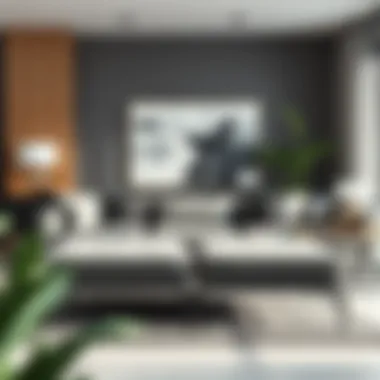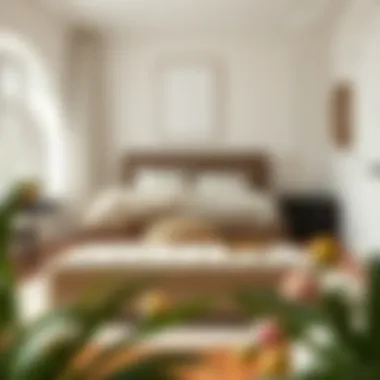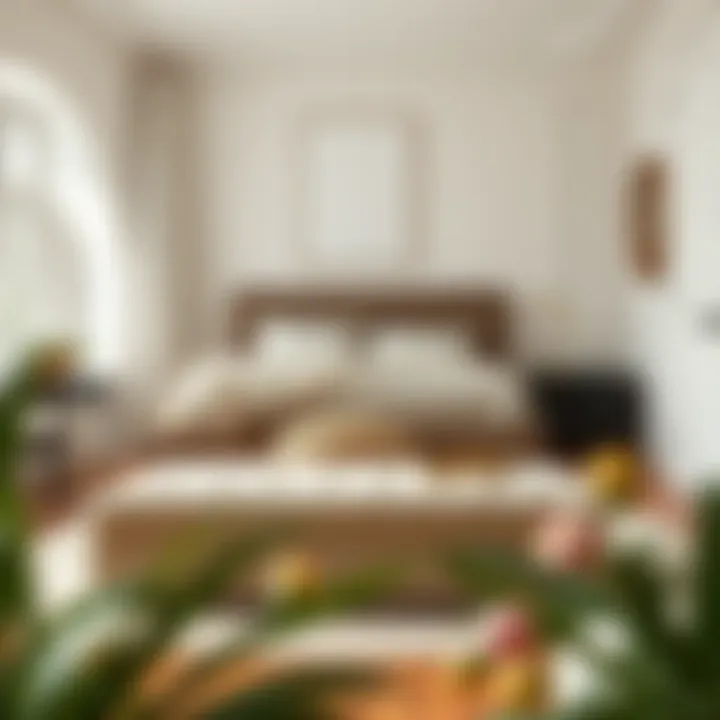Discovering the Versatile Benefits of Long Ottomans


Intro
Long ottomans, often overlooked in the vast realm of interior design, can serve as a versatile piece of furniture that elevates any living space. These elongated pieces not only offer function but also aesthetic enhancements, blending seamlessly into various design styles. Whether you’re a homeowner looking to refresh your living room or a designer seeking innovative ways to incorporate new elements, long ottomans can be a fantastic solution.
This guide dives deep into the world of long ottomans, discussing their practical uses, diverse styles, and tips for choosing the perfect piece for your space. By understanding the scope of possibilities these furniture items present, readers will gain insights into how to enhance their environments, all while maintaining practicality and comfort.
Instead of thinking of an ottoman as merely a footrest or a coffee table substitute, consider it a canvas on which to create unique expressions of style and function. Let’s explore how to make the most of these adaptable pieces and incorporate them effectively into our homes.
Design Trends
Current Trends in Furniture Styles
The furniture landscape is currently awash in a myriad of styles that embrace both form and function. Long ottomans have ascended in popularity partly due to the emergence of minimalistic designs and multifunctional furniture. No longer a mere accessory, these pieces serve as functional art, effortlessly fitting into modern décor while offering practicality.
- Sustainability: Eco-friendly materials are taking the spotlight. Long ottomans crafted from reclaimed wood or organic fabrics are not just stylish but also kind to the planet.
- Soft Edges: Designers are increasingly leaning towards pieces that offer soft, rounded edges, adding a touch of comfort and warmth. Long ottomans in soft materials like velvet or cushioned fabrics embody this trend beautifully.
- Bold Colors: A shift from muted tones to bolder colors allows homeowners to make a statement. Long ottomans in vivid hues or striking patterns can act as focal points in an otherwise subdued space.
How to Incorporate Trends into Your Space
Integrating these trends into your existing space can bring new life to your home. Here are some practical approaches:
- Consider the overall color palette of your room and choose an ottoman that either complements or contrasts effectively, creating a visual anchor.
- In small spaces, a long ottoman with built-in storage can address the need for functionality without sacrificing style.
- Swap out traditional coffee tables with a long ottoman. It offers more seating options and can also double as a footrest, optimizing your space usage.
“Long ottomans are not just pieces of furniture; they are gateways to expressing one’s style and creativity in interior design.”
Buying Guides
Choosing the Right Furniture for Different Rooms
When it comes to selecting the right long ottoman, context matters. Different rooms have distinct functions, and the ottoman needs to meet these specifications. For instance:
- Living Room: Choose a stylish yet sturdy ottoman that can bear the weight of drinks, snacks, or feet. Opt for those with plush upholstery for added comfort.
- Bedroom: A long ottoman at the foot of the bed can serve as a functional seat while also providing a spot to place extra pillows or blankets.
- Entryway: Consider a narrow ottoman that doesn’t overwhelm the space but provides a convenient place to sit while putting on shoes or to drop bags.
Tips for Assessing Quality and Value
Gauging quality is crucial when selecting a long ottoman. Here are some pointers to keep in mind:
- Material Matters: Examine the fabric and frame. Solid wood frames typically guarantee durability compared to particleboard.
- Cushion Quality: Sit on the ottoman to gauge the comfort of the cushions. High-density foam tends to offer more durability and comfort than softer, less supportive options.
- Warranties: Look for products with warranties, as they often indicate a manufacturer’s confidence in their furniture.
In summary, long ottomans have the potential to serve as much more than a simple accessory. With the right choices, they can effortlessly complement various interior designs, enhance the functionality of your space, and fulfill your unique style preferences. By following the guidance provided in this comprehensive guide, individuals can navigate the world of long ottomans with confidence.
Prolusion to Long Ottomans
Long ottomans represent a unique blend of functionality and style within modern interiors. As we delve into this comprehensive guide, it's crucial to understand their role in home design, where they serve not merely as an accessory but as a multi-purpose piece of furniture. These elongated pieces often go beyond traditional use; they are able to transform spaces and enhance comfort in ways that might not be immediately apparent.
For homeowners seeking to balance aesthetics with utility, understanding long ottomans is vital. They can complement existing décor while also providing additional seating or serving as a casual table for a drink or a book. From a designer's perspective, recognizing the various styles and functions that long ottomans can fulfill helps in creating cohesive spaces tailored to specific needs.
When incorporated effectively, long ottomans can act as a focal point in a room or blend seamlessly with the environment, depending on the intent behind the design. With their potential for storage or as a footrest, these versatile units cater to modern life demands. Thus, diving into their definition, historical significance, and evolution is essential to appreciate why they have earned a steadfast place in our homes today.
Definition and Overview
Long ottomans are generally characterized by their elongated shapes and cushioned tops. They typically range from four to eight feet in length. While they originated as footrests in classical designs, contemporary iterations have evolved into stylish options that serve many purposes.
In essence, a long ottoman can be a large cushion on legs or simply a padded form that resides flat on the floor. They are available in a variety of textures and styles, allowing them to fit both the traditional and modern aesthetics of any room. Furthermore, their multi-dimensional purpose can range from casual seating to decorative accents, offering homeowners flexibility in how they choose to implement them in their living spaces.
Historical Context
The history of ottomans stretches back into the Ottoman Empire, where they were often seen as a mark of luxury and sophistication. Initially, these pieces were used for lounging in a relaxed manner, clashing with more formal and rigid seating arrangements of the time. Over the years, as design trends shifted, so did the concept of furniture used for comfort.
The long ottoman, as we know it today, emerged in the late 18th and 19th centuries, becoming a staple in European parlors and living rooms. During this period, the classical footstool transformed into a more substantial presence, signaling a change in how people engaged with their environment, allowing a more laid-back approach to socializing. As cultures blended and styles merged, long ottomans adopted various forms and functions.
In the contemporary era, their usage has expanded even further. They are not restricted to sitting rooms, but rather have found a place in bedrooms, entryways, and even home offices, thus broadening our understanding of their versatility.
In sum, long ottomans trace a fascinating journey through history, evolving from functional objects of the elite into common yet stylish furnishings utilized in everyday life.
Types of Long Ottomans
Understanding the various types of long ottomans is essential for anyone looking to elevate their living space. This section highlights the significance of identifying right styles and materials, as well as functional attributes that can make a difference in your design choices and practical applications. As aesthetics blend with functionality, knowing how to choose effectively can turn a simple piece of furniture into a statement or a solution.
Classic vs. Contemporary Styles


When it comes to long ottomans, the styles can range widely from classic to contemporary. Classic styles often feature intricate details and rich materials that reflect a timeless elegance. Think of ornate carvings or tufted fabrics that hark back to historical designs. On the other hand, contemporary styles tend to embrace minimalism and straightforward lines, typically incorporating bold colors and innovative designs. The great thing about this variety is that homeowners can select a style that resonates most with their personal taste and harmonizes with existing decor, whether that be a vintage or a modern theme.
Fabric and Material Options
The materials used for long ottomans can greatly affect their overall appeal and functionality. Here we’ll dive into different fabric and material options:
Leather
Leather stands out as a robust material for long ottomans. Its key characteristic lies in its durability and luxurious feel, making it popular among upscale furnishing choices. Leather acts as a natural barrier against stains, which can be beneficial in high-traffic areas. However, it also comes with its share of considerations: while visually stunning, leather can be quite an investment and requires regular conditioning to maintain its luster.
Fabric Upholstery
Fabric upholstery offers versatile options, catering to various preferences and lifestyles. One of the most significant aspects of fabric is the vast range of patterns and textures available, allowing homeowners to express their individual style. Additionally, fabric is often more affordable than leather. Yet, it does have some drawbacks—certain fabrics may stain easier and require more regular cleaning compared to leather, especially in homes with pets or children.
Wood Accents
Wood accents on long ottomans can bring a natural element to a room. Typically, they provide sturdy structure and can enhance the overall aesthetic by adding warmth to a space. Wood is valued for its timeless quality, and when well cared for, it can last for generations. However, the weight of solid wood can make moving these ottomans a chore, and they might not fit easily in every design scheme.
Metal Bases
Metal bases are increasingly popular, particularly in modern designs. They offer a sleek, industrial touch that can lift the room’s aesthetic to a more contemporary realm. One advantage is their resilience and ability to support a great deal of weight, which can be great for multifunctional pieces. Still, metal may feel cold in certain designs and can scratch surfaces underneath if not properly protected.
Functional Variants
Long ottomans can also be categorized based on their functionality, giving even more options to homeowners.
Storage Ottomans
These serve double duty, functioning as both a stylish seat and a practical storage solution. The hallmark of storage ottomans is their compartmentalization—perfect for stashing away blankets, books, or even toys. They bring order into a living space without sacrificing design. Just part of the charm, but keep in mind that accessing items may involve lifting the top, which might hinder quick retrieval.
Convertible Ottomans
Convertible ottomans bring an interesting twist to seating. They can morph into something entirely different, like a bed or a table, depending on need. This adaptability is particularly useful in small spaces where multifunctionality is key. However, the mechanism of conversion should be durable to withstand regular changes, which can sometimes limit style choices in favor of practicality.
Footrests
Often understated, footrests play a supportive role in lounging areas. They elevate comfort levels by relieving stresses from the back and legs when relaxing. Surprisingly versatile, footrests can seamlessly blend with various decor styles. They might lack in storage capabilities but rank high on comfort, making them a favorite for those looking to maximize relaxation.
In summary, understanding the types of long ottomans enhances not only your design choices but also the functionality you desire in your living spaces. Each type brings its own unique benefits, and appreciating these differences is crucial in making an informed decision.
Design Considerations
When it comes to integrating long ottomans into your living space, understanding design considerations is paramount. A well-chosen long ottoman can serve not just as a piece of furniture, but as a statement of style and functionality. This section delves into essential factors such as proportions, color selection, and the overall balance in your decor, ensuring that your choice of ottoman contributes positively to your interior while fulfilling its practical uses.
Proportions and Dimensions
Proportions and dimensions play a central role when deciding where and how to place a long ottoman in your home. The ottoman should neither overwhelm the space nor be dwarfed by other pieces. A large, bold ottoman can act as a focal point, drawing attention and anchoring a room, especially in spacious living areas. Conversely, a smaller ottoman might serve well in a cozy nook or a tight entryway.
It’s vital to match the length of the ottoman to the surrounding furniture. For instance, a long ottoman can complement a lengthy sofa, creating a seamless flow and enhancing comfort when entertaining guests. Aim for a height that allows easy access to neighboring pieces—usually around 16 to 20 inches is a safe bet.
In practical terms, consider these insights:
- Measured Planning: Always measure the intended space. Not every room is built for every size.
- Versatile Options: Some ottomans come in adjustable sizes or modular forms, allowing flexibility as the needs of your household change over time.
"The right proportions can make a small room feel like a cozy nest or a large room feel inviting rather than empty."
Color and Pattern Selection
Color and pattern selection dramatically affects the vibe of your room. It’s an avenue for personal expression and can dictate the overall mood of a space. Long ottomans offer a unique opportunity to play with texture and hue. For instance, a bold, deep blue fabric can evoke calm, while a vibrant pattern might make a whimsical statement that invites conversation.
Neutral colors, like beige or gray, can provide a timeless, elegant touch that pairs well with other elements in a room, offering a balanced backdrop to brighter accessories. Keep in mind that patterns should complement existing décor rather than clash with them.
When selecting colors and patterns, consider the following:
- Contrast vs. Cohesion: How does the ottoman's color contrast with or complement walls, rugs, and other furniture?
- Material Influence: Different fabrics may present colors in varied lights. A velvet ottoman will look strikingly different from a linen one, even if dyed the same shade.
Balance and Harmony in Design
Design isn’t just about choosing the right piece; it’s about creating harmony in your space. When incorporating a long ottoman, think about balance. This involves not just visual appeal but how your furnishings interact.
To achieve balance and harmony:
- Symmetry: Create pairs with your ottoman; seating arrangements can be enhanced through symmetry, like placing matching ottomans on either side of a sofa.
- Height Variability: Mixing furniture styles and heights can add dimension. If your sofa is low, a higher ottoman can create a playful contrast, inviting interaction.
- Functional Form: Remember to consider how the ottoman functions within your space. Is it meant for resting feet, serving food, or providing additional seating? Each purpose can influence its placement.
Achieving this delicate blend often requires a bit of trial and error, but it’s vital for creating a welcoming environment.


Practical Uses for Long Ottomans
Long ottomans, often seen as mere decorative items, possess an astonishing versatility that enhances both function and aesthetics within living spaces. Their practical uses extend far beyond mere footrests, making them essential elements in modern home design. By understanding how to effectively incorporate long ottomans, homeowners can optimize their living areas, creating inviting and functional environments.
As Seating Solutions
One of the prime benefits of long ottomans is their role as additional seating. They can comfortably accommodate extra guests during gatherings, making them ideal for social occasions. Unlike traditional chairs that often look bulky, long ottomans provide a sleek alternative. Furthermore, their cushioned surfaces offer comfort without compromising visual appeal.
In a compact living area, a long ottoman positioned against a wall can serve as a makeshift bench while also enhancing the room's flow. This multifunctionality is appealing to homeowners who prefer to avoid clutter.
"A long ottoman can be a lifesaver in a tight spot, providing that extra seat while doubling as a stylish accent."
Serving as Coffee Tables
Another splendid use of long ottomans is as coffee tables. By their nature, they create a soft yet stable surface for placing drinks and snacks, making them a practical alternative to traditional coffee tables. The low profile of these ottomans means they can be placed right in front of a couch without reaching the height of standard tables, making it easier for guests to access.
When choosing to use an ottoman as a coffee table, it’s wise to consider the following:
- Material: Soft upholstery might need coasters to prevent stains.
- Size: Ensure it's proportionate to surrounding furniture for a balanced look.
- Storage Options: Many long ottomans come with storage space inside, useful for stashing away remotes or blankets, keeping the area tidy.
In this way, long ottomans add both functionality and a touch of elegance to living spaces.
Decorative Accents
Finally, long ottomans can be striking decorative accents in any setting. Their shape and fabric can significantly influence the ambiance of a room. For instance, a richly textured velvet ottoman can add a sense of luxury in a bedroom, while a sleek faux leather ottoman might underpin a contemporary lounge aesthetic.
When using long ottomans as decor, consider these ideas:
- Accent Color: Choose an ottoman that complements or contrasts with existing color palettes to enhance visual interest.
- Textural Contrast: Mix materials; pairing a soft ottoman with hard materials can create appealing textures.
- Layer with Other Decor: Position a stylish tray atop the ottoman to hold candles or books, creating a curated look.
The versatility of long ottomans allows them to act as more than mere furniture—they transform into essential components of modern home design, blending practicality with style.
Incorporating Long Ottomans into Different Spaces
Long ottomans possess a unique charm and adaptability that makes them a wonderful addition to a wide array of interior settings. Their versatility goes beyond mere aesthetics; they can serve multiple purposes while enhancing the room's overall vibe. This section delves into the significance of integrating long ottomans into various spaces, highlighting essential aspects that speak to their advantages and considerations for use.
In the Living Room
In the bustling heart of most homes, the living room stands out as a gathering area, often designed for comfort and style. Long ottomans can make a statement here, acting as both additional seating and practical footrests. Choosing a well-placed long ottoman often transforms how the space feels. It can provide a cozy spot for lounging or serve as a stylish alternative to traditional coffee tables. You might find that a leather or fabric-covered ottoman pairs beautifully with a plush sofa or a modern chair, creating a cohesive look.
The beauty of long ottomans is further accentuated when you incorporate them into your room's layout thoughtfully. Instead of having the typical coffee table, position a long ottoman in the center, allowing for games, magazines, or even a snack tray during movie nights. This not only enriches the experience for guests but also maximizes the use of available area.
Tip: Remember to consider the size of your living room when choosing an ottoman. A smaller room may benefit from a slender profile, while a more spacious area can accommodate wider options, which can enhance the visual balance.
In the Bedroom
The bedroom is often a personal sanctuary, and integrating a long ottoman can add an elegant touch to your space. Placing a long ottoman at the foot of the bed serves both aesthetic and practical functions. It offers a place to sit while getting dressed or provides additional storage if it's designed with a hidden compartment.
Moreover, an ottoman can break the monotony of a flat surface, creating dimension in the room. If you choose one with soft fabric or a patterned design, it can serve as a beautiful accent piece that ties together bedding and decor.
If your bedroom allows, think about the style; a vintage-inspired long ottoman might harmonize perfectly with a classic-themed room, while a sleek, minimalist design would suit contemporary styles better.
In Entryways and Hallways
Entryways and hallways are often overlooked when it comes to decor, yet a long ottoman can transform these often-narrow spaces into stylish and functional areas. An ottoman placed by the entrance can serve as a practical seat for putting on shoes or taking them off, minimizing the mess that can accumulate in these transitional areas.
In addition, you could highlight this space visually by choosing an ottoman that contrasts with the surrounding decor. For instance, a bright upholstered long ottoman against neutral walls can become a striking focal point. This can also help to create an inviting atmosphere as guests enter your home.
Considerations
- Size Matters: Ensure the ottoman fits without crowding the corridor.
- Style Choices: Think about the first impression you want to create, matching with your entryway aesthetics.
In Home Offices
In the modern age of flexible workspaces, long ottomans have made their way into home offices. While traditionally associated with living rooms or bedrooms, these versatile pieces can introduce comfort to professional environments. Utilize them as additional seating for meetings or as a makeshift coffee table when brainstorming ideas.
Placing an ottoman near your workspace offers a cozy and casual respite during long hours of work. If you have a calling that requires more creativity, a lively ottoman might spark inspiration. Moreover, a chic ottoman can provide a stylish storage solution for office supplies when not in use, helping keep your space tidy.
Final Thoughts
Incorporating long ottomans into various spaces is often a balancing act between practicality and style. Thoughtful selection and placement can enhance utility while enriching your interior design, making these multipurpose pieces truly invaluable.


Maintenance and Care
Long ottomans not only serve practical purposes but also add a certain flair to interiors. Much like any other furniture piece, they require attention to maintain their beauty and functionality. Focusing on maintenance and care can extend the life of your ottoman, preserving its charm and utility. Regular upkeep is essential; it protects your investment and ensures your living space remains inviting.
Cleaning and Upkeep
Cleaning your long ottoman should be a priority if you want to keep it looking fresh and appealing. The method you choose to clean will depend on its material. For instance, if your ottoman is upholstered in fabric, regular vacuuming is a must. Use a soft brush attachment to prevent fabric snagging while removing dust and debris. For spots and stains, a fabric cleaner suited for your ottoman's material is advisable.
If it's a leather ottoman, a gentle wipe with a damp cloth can do wonders. Don't forget to condition the leather with a suitable product every few months. This will help in preventing cracks and keeping the leather supple. You can also follow this by applying a protective spray designed for fabrics or leathers to give an added layer of defense against spills.
In essence, keeping your ottoman clean preserves its aesthetics and enhances your overall decor.
Repairing Damage
Accidents happen, and sometimes those accidents might involve your long ottoman. A tear, a dent, or a warped cushion can be disheartening, but addressing these issues promptly can save your ottoman from further deterioration. If the fabric is ripped, a fabric patch might work wonders. Carefully locate a patch with a good color match and cut it to size, securing it in place using fabric glue.
For more significant blemishes, like a puncture in leather, you may consider a leather repair kit. These kits typically contain a color-matching compound that, when used correctly, can conceal the damage effectively. If the legs of your ottoman are damaged, replacing them is often straightforward; all you need is to find a matching set and screw them in.
The key here is not to let minor blemishes evolve into larger problems. With regular assessments and prompt repairs, you can keep your ottoman in prime condition.
Protective Measures
Taking precautions can save you from fifty headaches down the road. Consider placing your long ottoman away from high-traffic areas where it can get bumped or scratched easily. Area rugs or mats can also provide a buffer against inevitable wear and tear, especially in homes with pets or children.
Using coasters or trays when placing items on your ottoman serves to minimize damage caused by moisture or heat. Likewise, a stylish throw can add an extra layer of protection while enhancing your decor. When you notice a potential hazard, like spillage or sharp objects, take proactive measures to prevent damage before it occurs.
In summary, maintenance and care for long ottomans is about detail and diligence. "An ounce of prevention is worth a pound of cure" rings especially true in this context. Stay proactive, and you’ll enjoy your ottoman’s beauty and functionality for many years to come.
Selecting the Right Long Ottoman
Choosing the right long ottoman is crucial in enhancing both the functionality and the aesthetic appeal of a space. Since these pieces serve multiple purposes, from extra seating to stylish decor, it's essential to think through several practical aspects before making a decision. This process involves assessing your needs and considering how the ottoman will fit into your environment, ensuring that you select one that not only looks good but also serves its intended purpose effectively.
Assessing Space Requirements
When it comes to selecting a long ottoman, the first step is to assess the available space. Ottomans come in various sizes, and you need to ensure that the piece you choose fits nicely within your room without overwhelming the existing furniture. A good starting point is to measure the area where you plan to place the ottoman. Consider how much room you have for movement—people need to walk freely around the ottoman without bumping into it.
Place a piece of masking tape on the floor to outline the dimensions of the ottoman to visualize how much space it will take. This way, you can evaluate how the size interacts with your other furnishings, like coffee tables, chairs, or sofas. If you have a small space, opting for a streamlined design and lower profile can help avoid the feeling of being cramped. Larger rooms, on the other hand, afford more leeway for bolder designs.
Establishing a Budget
Setting a budget is another important factor while picking the right ottoman. With a wide array of prices in the market, having a clear budget can help narrow down your options. Decide how much you're willing to spend and then explore products that fit within that financial range. Keep in mind that sometimes, investing a bit more upfront can yield better quality, which might save you money in the long run—especially if you choose a durable piece that withstands the wear and tear of everyday use.
Before making a purchase, consider additional costs, such as delivery or assembly fees. These can add up quickly and might influence your choice. It is worth checking whether local retailers provide discounts or financing options. Remember, patience pays off; the right deal may take a bit of searching.
Choosing Quality Over Cost
When selecting a long ottoman, sometimes it’s tempting to go for the lowest price, but prioritizing quality is essential for long-term satisfaction. An ottoman is not just a decorative item; it's a part of your home that will experience daily use. Check the materials used: solid wood frames often indicate durability compared to particle board, which might warp over time.
Look for high-quality upholstery as well. Opt for fabric types that are resistant to stains and wear while also being pleasant to the touch. This could include microfiber or treated fabrics that are easier to clean. Additionally, inquire about the ottoman's construction. Reinforced stitching and secure joints signify a robust piece built to last. By focusing on quality, you can ensure that your investment in a long ottoman pays off, enhancing your space for years to come.
The right long ottoman can successfully bridge function and design, serving as a statement piece while fulfilling various needs in your home.
For those looking to dive deeper into the world of ottomans, consider visiting resources like Wikipedia or exploring discussions on Reddit about personal experiences and recommendations.
Ultimately, narrowing down your choices based on space, budget, and quality will empower you to make an informed decision. Invest time in the selection process, and you will likely find an ottoman that elevates the design of your home while providing practical solutions.
Culmination
Long ottomans have carved a unique niche in modern interior design, proving themselves to be more than just an accessory; they are versatile furniture pieces that enhance both function and style in any setting. As we reflect on their significance, several key elements emerge that underscore their value to homeowners, designers, and furniture enthusiasts alike.
Reflecting on the Role of Long Ottomans
In today’s fast-paced world, efficiency is at the forefront, and long ottomans exemplify this by serving multiple purposes. They are not just places to put up your feet or a makeshift table for a cup of coffee; they are vessels for storage, additional seating solutions, and artistic focal points. Their adaptability allows them to harmonize with various design styles, from minimalist to elaborate, ensuring that there’s a perfect fit for every personal taste. Homeowners appreciate this multifunctionality, as it enables smaller spaces to feel less cluttered while still providing essential functionality.
For designers, incorporating long ottomans into a layout adds layers of texture and dimension, contributing to a more cohesive look. They can serve as a bridge between disparate design elements, creating a flow that ties a room together. Furthermore, their availability in an array of materials and finishes allows for creative expression, resonating with individual aesthetics and preferences.
"Long ottomans don't just fill spaces; they transform them into cozy retreats."
The Future of Long Ottoman Designs
As we gaze into the horizon of interior design trends, the future of long ottoman designs looks promising. With the rising popularity of sustainable materials, it'll be interesting to see how manufacturers adapt and innovate to align with eco-conscious preferences. Expect to see a surge in ottomans made from reclaimed woods, organic fabrics, and non-toxic finishes, appealing to environmentally-minded shoppers.
Moreover, technological integration may find its way into ottoman designs. Imagine long ottomans with built-in charging stations or Bluetooth capabilities that accommodate the tech-savvy crowd. As home environments evolve into more multifunctional spaces, this integration could elevate the humble ottoman into a crucial piece of modern furniture.
With the increased attention to personalized spaces, custom designs tailored to individual needs and preferences will likely gain traction. From unique shapes to tailored sizes, the possibilities are expanding. This evolution suggests that long ottomans will continue to thrive in diverse settings, adapting to the changing needs of homeowners and reflecting broader aesthetic shifts in home decor.
In summary, long ottomans are not merely furniture; they are integral components of our living spaces, offering practicality, versatility, and opportunities for personal expression. As we look to the future, they are sure to maintain their relevance and charm in any home.













